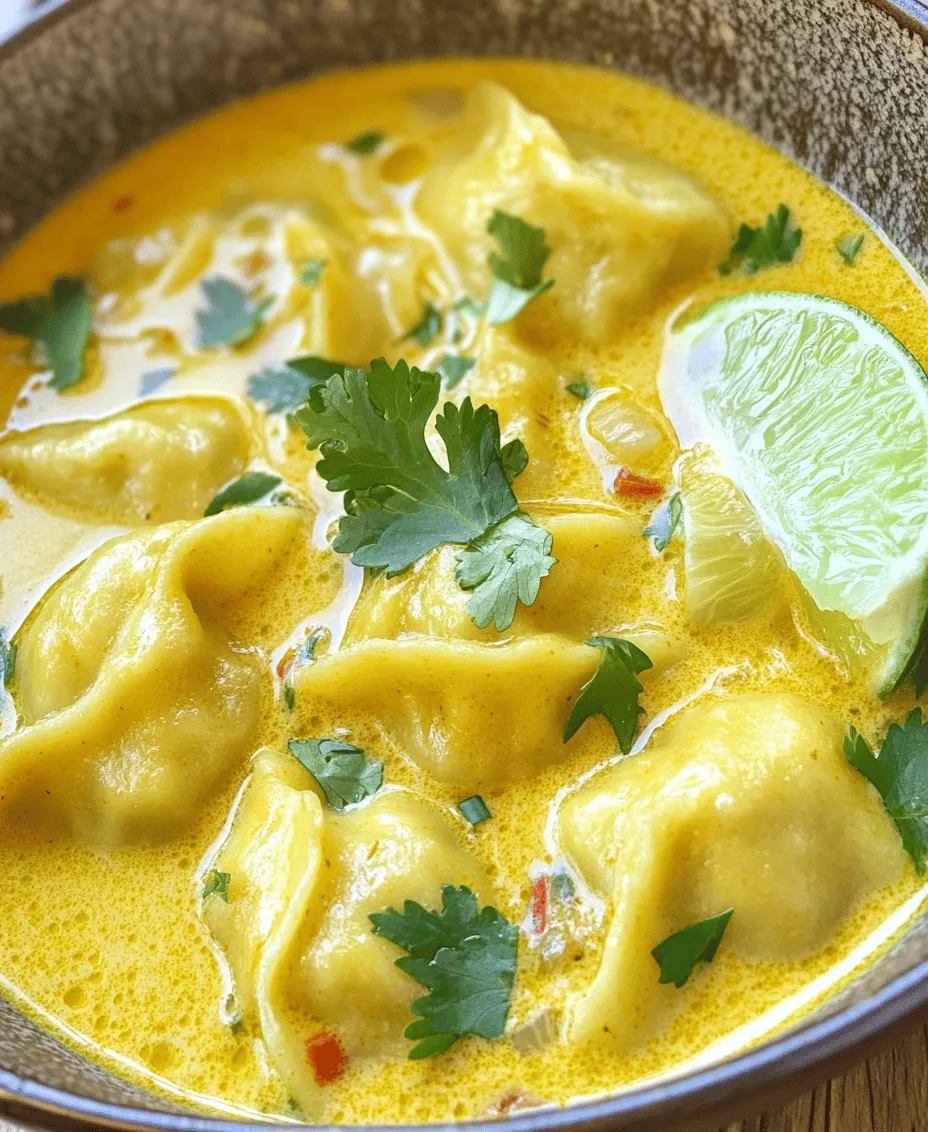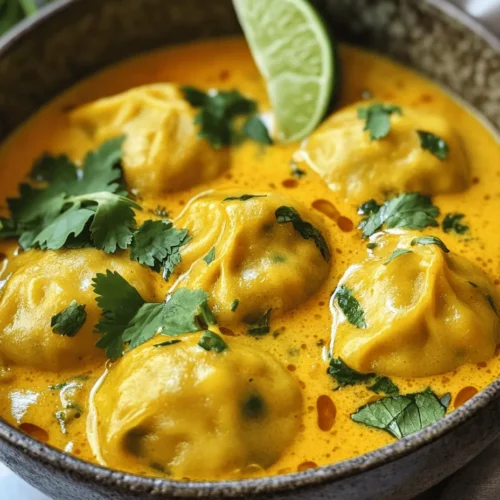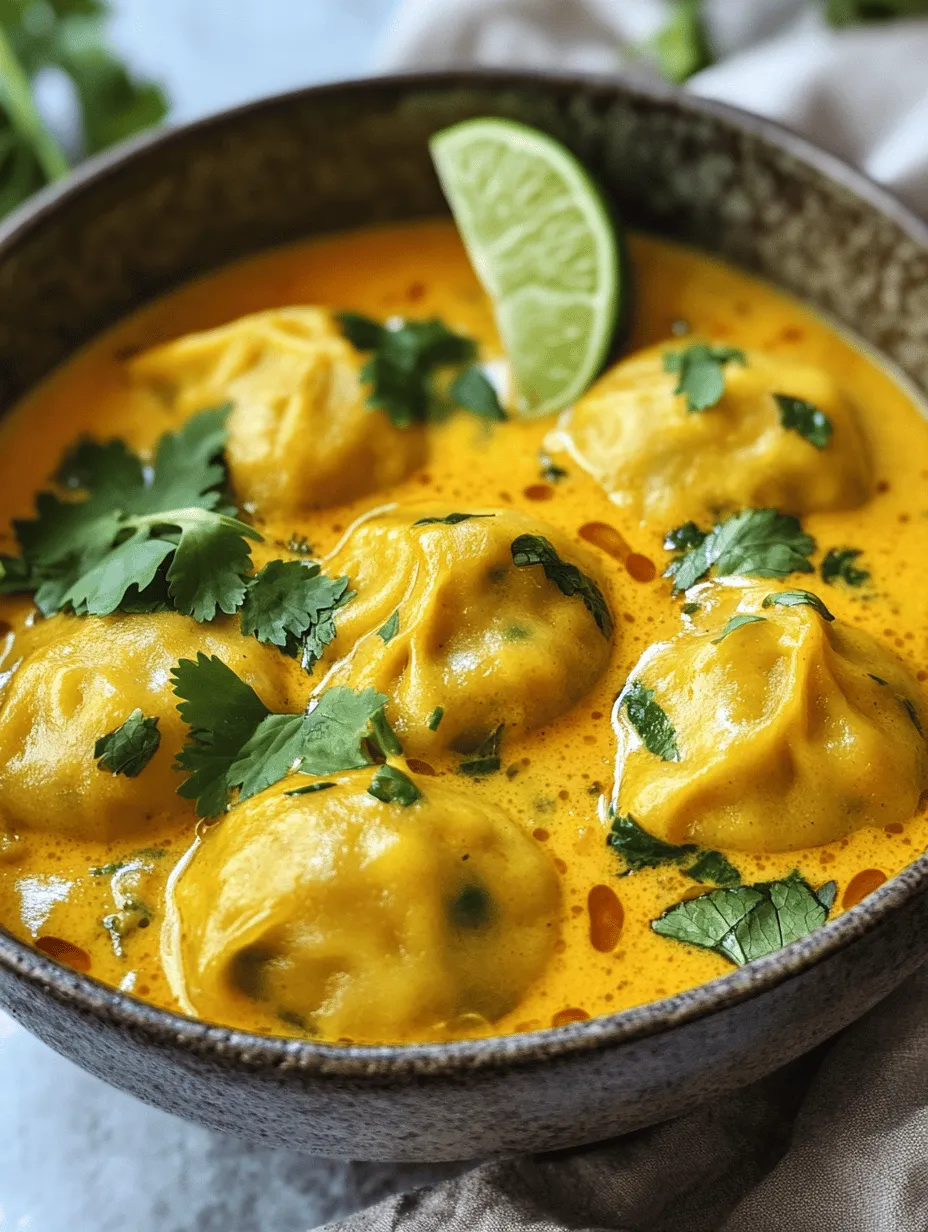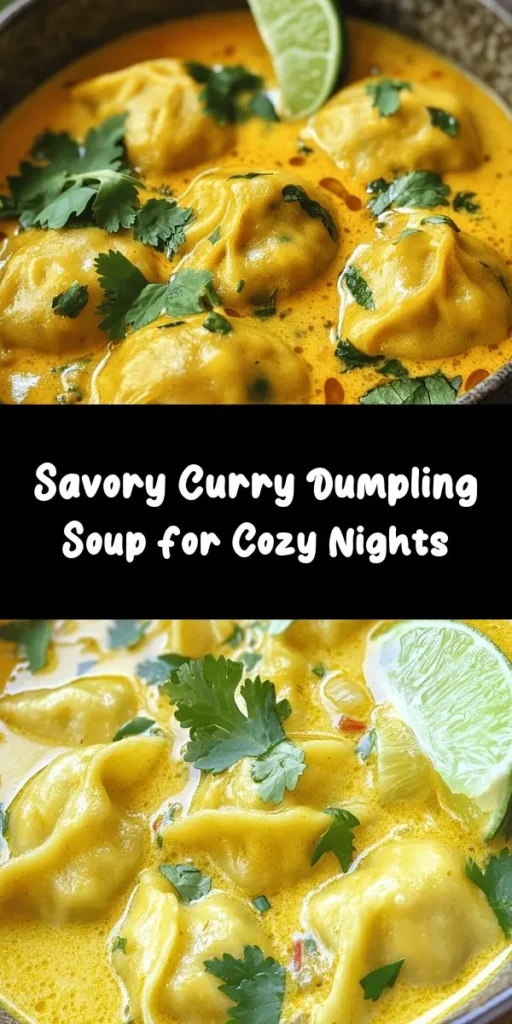Introduction
Delve into the rich and comforting world of Asian cuisine with this delightful recipe for Best Curry Dumpling Soup. This dish not only warms the soul but also fills the belly with its combination of savory dumplings and aromatic broth. Bursting with flavors, this soup is a true representation of the harmonious balance that defines much of Asian cooking. The dumplings, stuffed with a medley of fresh vegetables and spices, complement the fragrant curry-infused broth, creating a symphony of taste and texture that is hard to resist.
In this article, we will explore the ingredients that make this dish unique, the preparation methods that ensure a delightful outcome, and the cultural significance behind this beloved recipe. Emphasizing the use of fresh vegetables and aromatic spices, this soup is perfect for a cozy evening or a gathering with family and friends.
Understanding the Ingredients
Exploring the Dumpling Ingredients
The dumpling is the heart of this soup, and the ingredients used play a crucial role in both flavor and texture. Here’s a closer look at what goes into making these delightful morsels:
1. All-Purpose Flour:
All-purpose flour is the foundation of the dumpling dough. It provides the necessary structure and chewiness that makes dumplings so delightful. When combined with water, it forms a pliable dough that can be rolled out and shaped easily. The gluten in the flour allows the dumplings to hold their shape when cooked, ensuring that they are tender yet sturdy enough to contain the flavorful filling.
2. Turmeric Powder:
Turmeric is not just a vibrant yellow spice; it is also known for its health benefits. Adding turmeric powder to the dumpling dough enhances not only its color but also brings anti-inflammatory properties to the dish. Its warm, earthy flavor complements the other ingredients perfectly, making it a staple in many Asian recipes.
3. Fresh Vegetables:
Fresh vegetables such as carrots, spinach, and bell peppers not only add nutrition but also contribute to the overall flavor profile of the dumplings. Carrots provide a natural sweetness and a satisfying crunch, while spinach adds a subtle earthiness and deep green color. Bell peppers introduce a slight tang and sweetness, creating a colorful and nutritious filling that is both satisfying and healthy.
4. Aromatics:
Aromatics like onion, garlic, and ginger are essential for flavor development. Sautéing these ingredients before adding them to the dumpling filling enhances their flavors and creates a fragrant base that elevates the entire dish. The combination of these aromatics gives the dumplings a depth of flavor that is both comforting and inviting.
5. Soy Sauce and Sesame Oil:
These ingredients play a vital role in adding umami and richness to the dumpling filling. Soy sauce provides a salty and savory depth, while sesame oil adds a nutty aroma and richness. Together, they round out the flavors of the filling, ensuring that each bite is packed with taste.
Diving into the Soup Ingredients
The broth in this recipe is just as important as the dumplings themselves. Here’s what goes into creating the perfect soup base:
1. Vegetable Broth and Coconut Milk:
These two ingredients form the backbone of the soup. Vegetable broth provides a savory base that enhances the flavors of the dumplings, while coconut milk adds creaminess and a hint of sweetness. This combination creates a rich, comforting broth that perfectly complements the dumplings.
2. Red Curry Paste:
Red curry paste is a blend of various spices and herbs, including red chilies, garlic, lemongrass, and galangal. It is a staple in Thai cuisine and brings a complex flavor to the soup. The spiciness of the curry paste can be adjusted according to your preference, making it a versatile ingredient for any heat level.
3. Balancing Flavors:
To achieve a well-rounded flavor profile, we incorporate soy sauce, lime juice, and brown sugar into the broth. Soy sauce adds an additional layer of umami, while lime juice introduces a bright acidity that balances the richness of the coconut milk. A touch of brown sugar rounds out the flavors, creating a harmonious blend that is both satisfying and delicious.
4. Finishing Touches:
Finally, garnishing the soup with fresh cilantro and lime wedges adds a burst of freshness and brightness. The cilantro not only enhances the visual appeal but also introduces a layer of herbal complexity that elevates the overall experience. Squeezing a wedge of lime over the soup just before serving brightens the flavors and provides a refreshing finish.
Preparing the Dumplings
Now that we understand the importance of each ingredient, let’s move on to the preparation steps for making these delightful dumplings.
Making the Dough
Creating the perfect dumpling dough is crucial for achieving the right texture. Here’s a step-by-step guide to help you master this process:
1. Combine Ingredients:
Start by measuring out the all-purpose flour into a mixing bowl. Add a pinch of salt to enhance the flavor of the dough. Gradually add warm water to the flour, mixing it with your hands or a wooden spoon until a rough dough begins to form.
2. Knead the Dough:
Once the mixture has come together, transfer it to a lightly floured surface and knead the dough for about 5-7 minutes. The goal is to develop the gluten, which will create a chewy and pliable texture. If the dough feels too sticky, sprinkle a little more flour as needed.
3. Rest the Dough:
After kneading, wrap the dough in plastic wrap or cover it with a damp kitchen towel. Allow it to rest for at least 30 minutes at room temperature. This resting period is essential as it relaxes the gluten, making the dough easier to roll out and shape later on.
Crafting the Filling
The filling is where you can get creative and customize the flavors to your liking. Here’s how to prepare a delicious filling for your dumplings:
1. Sautéing Vegetables:
Begin by heating a tablespoon of oil in a skillet over medium heat. Add finely chopped onions, garlic, and ginger, and sauté until they are fragrant and the onions are translucent. This step is crucial as it releases the essential oils from the aromatics, infusing the filling with flavor.
2. Add Vegetables:
Next, add the chopped carrots and bell peppers to the skillet. Sauté for an additional 3-4 minutes until the vegetables are slightly softened but still retain their crunch. Finally, add the spinach and cook just until wilted.
3. Season the Filling:
Once the vegetables are cooked, remove the skillet from the heat and stir in soy sauce, sesame oil, and a sprinkle of turmeric for an added flavor boost. Ensure the filling is well combined and seasoned to your liking.
4. Cool the Filling:
It’s important to let the filling cool before assembling the dumplings. This prevents the dough from becoming too warm and ensures that the dumplings hold their shape during cooking. Spread the filling out on a plate to speed up the cooling process.
Forming the Dumplings
Now that you have your dough and filling ready, it’s time to assemble the dumplings. Here’s how to do it:
1. Roll Out the Dough:
On a lightly floured surface, roll out the rested dough into a thin sheet, about 1/8 inch thick. Use a round cutter or a glass to cut out circles from the dough. Aim for a diameter of about 3 inches for each dumpling.
2. Fill the Dumplings:
Place a small spoonful of the cooled filling in the center of each dough circle. Be careful not to overfill, as this can make it challenging to seal the dumplings.
3. Seal the Dumplings:
To seal the dumplings, fold the dough over the filling to create a half-moon shape. Press the edges together firmly to ensure there are no gaps. You can also crimp the edges with your fingers or a fork for a decorative touch.
4. Prepare for Cooking:
Once all the dumplings are formed, you can cook them immediately or freeze them for later use. If freezing, lay them out on a parchment-lined baking sheet until firm, then transfer them to a freezer bag for storage.
With the dumplings prepared, you are now ready to move on to cooking the soup and combining all the elements for a truly comforting dish. Whether you serve it on a chilly evening or at a festive gathering, this Best Curry Dumpling Soup is sure to impress with its rich flavors and delightful textures.

Visual Guide on Rolling and Sealing Dumplings
When it comes to making dumplings, mastering the art of rolling and sealing is essential for achieving that perfect bite. Start with a portion of your dough, roughly the size of a golf ball. On a lightly floured surface, roll the dough into a thin circle, about 3 inches in diameter. The edges should be thinner than the center to allow for a nice seal and to create a tender texture when cooked.
Different Folding Techniques for Various Styles of Dumplings
There are several popular folding techniques you can use to seal your dumplings, each offering a unique look and texture:
1. Half-Moon Fold: Place a spoonful of filling in the center of the dough circle, fold it in half, and pinch the edges together to seal. This is the simplest method and works well for steaming or boiling.
2. Pleated Fold: For a more decorative dumpling, use the half-moon fold as a base. Starting from one end, make small pleats along the edge while pinching to seal. This not only looks appealing but also allows for more filling.
3. Twisted Fold: Start with the half-moon shape, then twist the edges together like a rope. This method adds a unique presentation and is great for frying.
4. Bowl Shape: For a soup dumpling, create a bowl shape by gathering the edges of the dough around the filling and pinching them together at the top. This technique is perfect for dumplings that need to retain broth.
Once you’ve sealed your dumplings, place them on a floured surface or parchment paper to prevent sticking until you’re ready to cook them.
Creating the Soup Base
The soup base is just as crucial as the dumplings themselves. It serves as the flavorful foundation that ties the dish together.
Combining Flavors
Begin with a base of aromatic ingredients. Heat a tablespoon of oil in a large pot over medium heat, then add diced onions, minced garlic, and grated ginger. Cook until the onions are translucent, about 3-5 minutes. Next, stir in your spices: curry powder, turmeric, and a pinch of cayenne for heat. Toasting the spices in the oil releases their essential oils, enhancing the flavor.
After the spices are fragrant, add diced tomatoes or tomato paste, followed by vegetable or chicken broth. This mixture forms the basis of your soup. For added depth, consider incorporating soy sauce or fish sauce, which will lend umami notes to the broth.
Importance of Simmering for Developing a Rich Broth
Once your ingredients are combined, bring the broth to a gentle simmer. This slow cooking process allows the flavors to meld beautifully. Simmer for at least 20 minutes, stirring occasionally. If time allows, you can simmer for longer; the richness of the broth will only improve. Taste and adjust the seasoning with salt, pepper, or additional spices as desired.
Cooking the Dumplings
Now that your soup base is ready, it’s time to cook the dumplings.
Techniques for Cooking Dumplings in the Soup
There are a couple of methods to cook dumplings in soup, both yielding delicious results:
1. Simmering in the Broth: Gently add the dumplings to the simmering broth. Ensure the broth is not at a rapid boil, as this can cause the dumplings to break apart. Cook for about 6-8 minutes, or until they float to the top, indicating they are done.
2. Steaming Then Adding: For a different texture, you can steam the dumplings separately and then add them to the broth just before serving. This method keeps the dumplings intact and prevents them from becoming overly saturated.
Identifying Doneness: How to Know When the Dumplings Are Ready
Dumplings are generally done when they float to the surface of the soup, but you can also check by cutting one open. The filling should be hot and cooked through, while the dough should be tender yet firm. If your dumplings are larger, you may need to extend the cooking time slightly.
Serving Suggestions
Once everything is cooked, it’s time to serve your beautiful curry dumpling soup.
Plating the Dish
For an appealing presentation, ladle the soup into deep bowls. Place a few dumplings in the center, allowing them to float atop the broth. To enhance the dish’s visual appeal, garnish with fresh cilantro, chopped green onions, and a drizzle of coconut milk or a swirl of chili oil for a pop of color.
Suggestions for Side Dishes That Complement Curry Dumpling Soup
Pair your curry dumpling soup with light and refreshing side dishes. Consider a simple green salad with a citrus vinaigrette or steamed vegetables seasoned with sesame oil. You might also serve some crusty bread or naan on the side to soak up the delicious broth.
Pairing Beverages
To elevate your meal experience, consider beverage pairings that complement the spices and flavors of your curry dumpling soup.
Recommended Drink Pairings to Enhance the Meal Experience
– Herbal Tea: A warm cup of chamomile or ginger tea can offer a soothing balance to the spices in the soup.
– Light Beer: A crisp lager or pale ale can cleanse the palate while enhancing the flavors of the dish.
– White Wine: A chilled Sauvignon Blanc or a slightly off-dry Riesling pairs well with the spices and richness of the soup.
Cultural Significance of Dumpling Soup
Dumpling soup is more than just a dish; it carries a rich cultural heritage and evokes feelings of nostalgia and family togetherness.
Exploring the Origins
Historically, dumplings have been a staple in many Asian cuisines, with origins tracing back thousands of years. They are often associated with significant family gatherings and celebrations. In Chinese culture, for example, dumplings are traditionally eaten during the Lunar New Year as a symbol of wealth and prosperity.
The Role of Dumpling Soup in Family Gatherings and Celebrations
During festive occasions, families come together to prepare and enjoy dumpling soup, symbolizing unity and sharing. Each family may have its own unique recipe, often passed down through generations. The act of making dumplings together can be a bonding experience, filled with laughter and stories.
Modern Variations
As culinary traditions evolve, so do recipes. Today, you can find numerous variations of dumpling soup across different cultures.
Overview of How Different Cultures Adapt Dumpling Soup
In Japan, for instance, you might find a miso-based broth with gyoza-style dumplings, while Korean cuisine features mandu served in a spicy broth. Each version reflects the local ingredients and tastes, showcasing the versatility of dumplings.
Suggestions for Personalizing the Recipe to Suit Different Tastes
Feel free to personalize your curry dumpling soup by experimenting with different fillings or using alternative broths. For a vegetarian version, try mushroom or spinach filling. You can also adjust the spice level according to your preference, or add vegetables like bok choy or carrots to the broth for extra nutrition.
Conclusion
In summary, the Best Curry Dumpling Soup is not just a meal; it’s a celebration of flavors, textures, and cultural heritage. With its comforting warmth and vibrant ingredients, this dish can easily become a staple in your culinary repertoire. Whether enjoyed on a chilly evening or shared with loved ones, this recipe highlights the joy of cooking and the satisfaction of sharing a homemade meal. Embrace the process, and savor each bite of this delightful dumpling soup.



